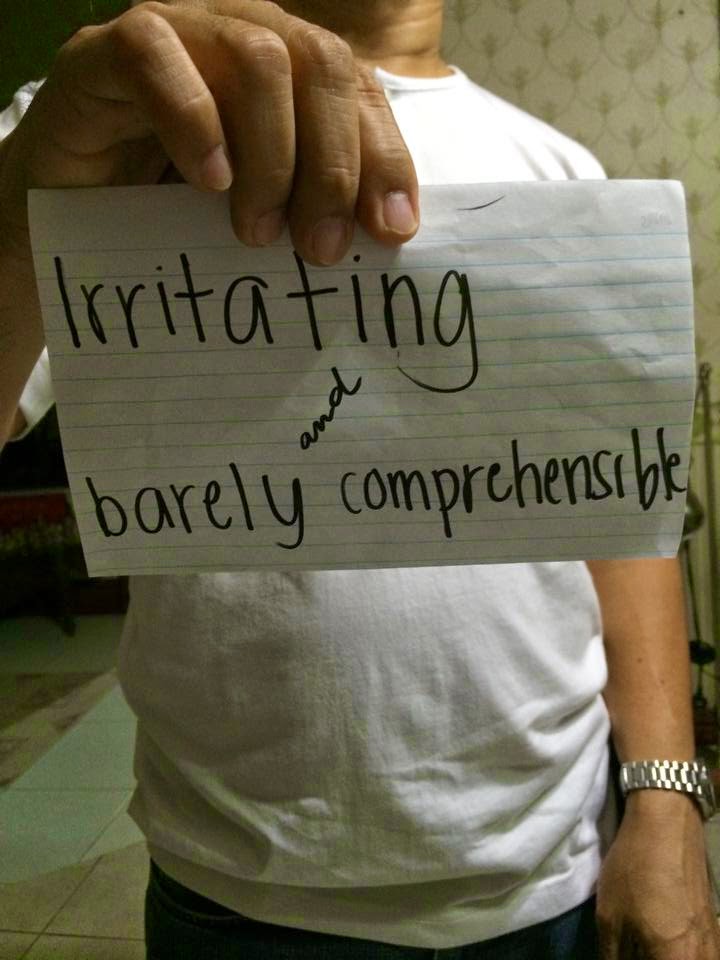"What do you think about gay language?"
Language
is a non-material culture that serves as the primary medium for communication
of people. One of its vital functions in the society is being a “symbol”
- of a subculture, beliefs, values, and whatnot. Moreover, language reflects
the kind of “culture” the people making use of it share. A particular language
may embody a specific culture different from what another language does because
of a different societal context. Therefore, it is an important part of culture
per se.
On the
other hand, the society also has subcultures that are formed because of
“isolated” or “different” cultures that only a part of a population share. One
of the most popular subcultures is the gay culture. Because of a different gender
identity that is deviating from the social norms of gender, which are the
biological sexes male and female, gays are able to form their own subculture
that allows them to share this “gender identity culture” among the members of
the aforementioned “group".
Gays,
having their own subculture, have created a way to express themselves, and this
is through having their own kind of language. This gay language has transcended
popular culture through the social interactions of gays using this language
with other people. This phenomenon has created an impact not only to gays
themselves, but to other people with different gender identity.
This “impact” to the society of gay language is what made it
interesting to the researchers. To be able to know people’s perspectives on
this matter, they conducted an interview to people with varying ages, social
classes, and social institutions that shape their view on things. Interviewing
people representative of the groups mentioned above would provide sufficient
knowledge to the researchers on how people view the gay language in the
contemporary society. Therefore, it could show how people perceive this
language of this particular subculture existing nowadays.
Age
Language is a non-material culture that serves as the primary medium for communication of people. One of its vital functions in the society is being a “symbol” - of a subculture, beliefs, values, and whatnot. Moreover, language reflects the kind of “culture” the people making use of it share. A particular language may embody a specific culture different from what another language does because of a different societal context. Therefore, it is an important part of culture per se.
Age
 |
| Jan, 4, Kid #culture #gay #language #panget |
 |
| Marian, 6, Kid #culture #gay #language #nakakatawa #ibasapandinig |
 |
| Angel, 17, Teenager #culture #gay #language #flamboyant |
 |
| Krisha, 17, Teenager #culture #gay #language #wagmatakotmakibeki |
 |
| Kat, 28, Professional #culture #gay #language #humor #boompanes |
 |
| Martin, 30, Professional #culture #gay #language #amusing #creative |
 |
| Imma, 47, Adult #culture #gay #language #gaysmark |
 |
| Pablo, 49, Adult #culture #gay #language #irritating #barelycomprehensible |
Social Class
 |
| Miguel, 20, Upper Class #culture #gay #language #weirdandfascinating |
 |
| Alexis, 18, Upper Class #culture #gay #language #colorful |
 |
| Mannex, 41, Working Class #culture #gay #language #corny #walangbasaganngtrip |
 |
| Jocelyn, 44, Working Class #culture #gay #language #nakakahawa |
"Nakakahawa.
Minsan may ibang gay na barumbado yung pananalita merong iba na professional
talaga." (NONVERBATIM)
Social Institution
 |
| Hercs, 33, Catechist #culture #gay #language #sanamagingformal |
 |
| Angie, 40, Catechist #culture #gay #language #mahirapintindihin |
"Hindi ko siya gusto. Mahirap
intindiin, pinapalawak yung lengguwahe natin at nagagaya kasi ng mga bata." (NONVERBATIM)
 |
| Beth, 57, Mother #culture #gay #language #unstoppable |
 |
| Ding, 57, Father #culture #gay #language #shouldnotaffectthelocaltongue |
 |
| Corazon, 65, Lola #culture #gay #language #hindimaintindihan |
 |
| Den, 65, Lolo #culture #gay #language #gender #shouldnotbeencouraged |
 |
| Mia, 18, Student #culture #gay #language #unique |
 |
| Ana, 39, Teacher #culture #gay #language #cool |
Generally, the answers of our respondents showed that they were very much aware of the gay language or gay lingo. Although some gave negative opinions, everyone accepts that the gay language is very much a part of our culture today.
To be specific, most of the elderly, belonging to the 36 and above age group who were mostly parents and grandparents, imparted anti-gay language responses as they thought of it as a bad example to children and very annoying and hard to understand. While some opinions were very closed off and completely opposing, there were some which still pointed out the more positive side of the said language. On the other hand, the people belonging to the younger part of the age groups were very much 'okay' with gay lingo. They have come to see the positive side of having a diverse language as it shows the flamboyance and creativity of the gay community. They think that this language is able to express and represent them well.
In terms of the social classes and social institutions, however, there were no specific patterns that stood out. It does not matter whether one is from the upper class, or a member of a religious organization; all their responses varied depending on their age.
There were not much 'aha!' moments for the group, as we expected that the elderly are more guarded in terms of the various social changes happening nowadays. They are worried that this language would affect the local tongue and also the children (although it already has). The younger generation showed a more open mind perhaps because they get to interact with the gay community more, and they get to experience this creative and expressive language and also see the positive side of it.
As time progresses, our language continues to diversify. While this may be a bad thing as we lose the old culture with the old language, we create, however, a new culture through a new diverse language which is more appropriate for the changing era.
Final Project by CGMSL from SA21 - C (Cabug, Gutierrez, Malabanan, Santos, Llaneta)
No comments:
Post a Comment